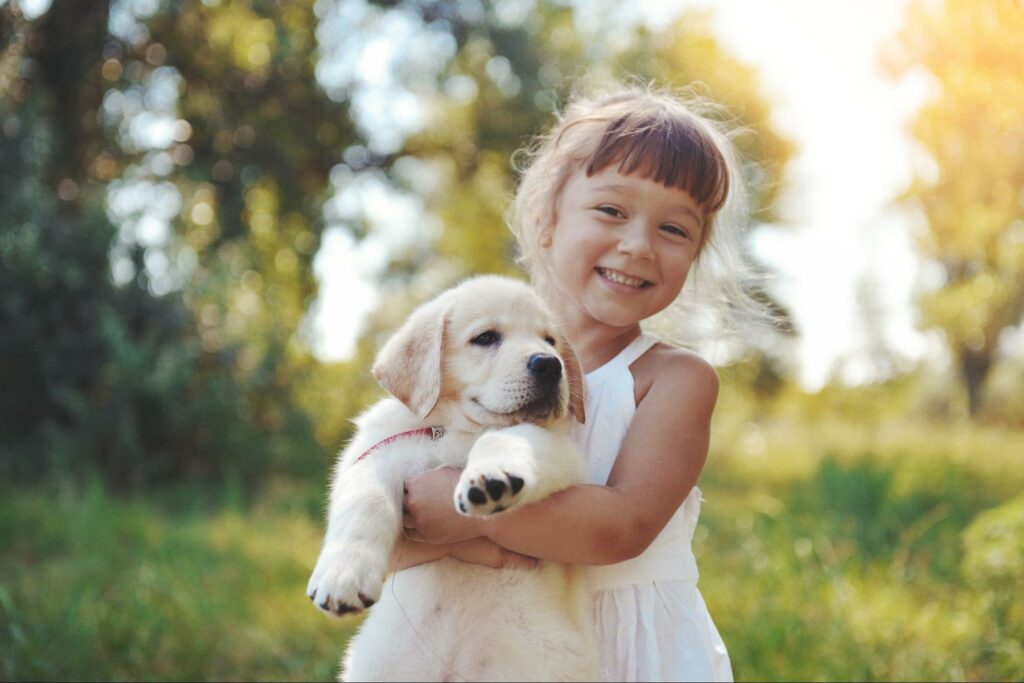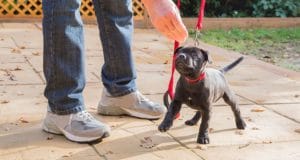Kids and puppies have lots in common: They’re inquisitive, impatient, and easily excited! This is why it’s important to carefully supervise first encounters between a new puppy and your children. The rewards can be wonderful — a truly close bond and a lifelong love of dogs. But, if you don’t take precautions, a few mistakes could lead to a much less happy ending.
The Beginning: Looking for a New Puppy
When you first start thinking about getting a new dog, you often think of the kid’s benefits first. Many kids love to play with dogs and have a special connection with them. So, do your best to involve your child in the process of looking for a new puppy, whether it’s online or in person.
When searching, keep in mind the needs of you and your family. It may be beneficial to pick out a few options and begin your research on the breed’s personality or how well they interact with children in general.
A dog may catch their eye that they wish they could take with them to their new home, so research the background of your preferred breeds before going to visit.
After all, you want everyone in the family to be happy and fulfilling the kid’s wish to adopt a certain dog breed can make them feel very special.
Setting The House Rules
Before meeting your new friend, make sure you have house rules established that every member of the family understands. Just as you will train your dog, you should teach your child the rules of having a new dog in the house.
Be sure to discuss other kid topics, like needing to be careful, no teasing, and how to respect the family pet.
Here are some suggestions:
- Instead of ‘no shouting around the dog’ the rule could be ‘quiet voices only around the dog’s and keep a calm & assertive energy.
- Rather than telling your child to never poke, squeeze or pull at the puppy, tell them to pet the dog gently and only stroke the dog when the dog comes to them. This will teach the child to respect boundaries and bring more trust to your dog.
- When the dog is sleeping it’s time for us to get some long-awaited child activities done! Children can sometimes feel entitled to places where their dog does not want them; teaching children that these are no-go zones and giving your dog a safe place to relax is important for everyone’s safety.
The First Meeting
Once you’ve found a few options and have gotten your child’s input, it is important to visit the dogs you are interested in before you commit to getting it. Not all rescue dogs will work well for kids, so it’s important to find out about the dog’s personality and energy level.
If your kid has never had much direct contact with dogs, he or she may be intimidated and need some help when first meeting a potential puppy. Be sure to guide them in a slow approach and let the dog come to them. This will enable your dog to meet them on their own terms and is a great way to form a strong bond of trust between the two, from the beginning.
Now is a good time to bring up things like “don’t get too close, don’t look them in the eyes, and don’t pet without asking” if your kid isn’t familiar with dog body language.
If you notice any sign of fear or nervousness on your child’s part, end the meeting. This shouldn’t be a time to push the kid to overcome their fear. This is a time for your kid to get accustomed and comfortable with a potential new member of the family.
10 Steps for Bringing Your New Puppy Home
After doing your research and visiting some puppies, you’re finally prepared to take your new family member home! Be sure to follow these tips:
- Until you’re sure that the puppy and the child know how to behave around each other, you should always be present. Stay in the background, but be observant and ready to step in if a situation looks like it’s going wrong.
- Let the puppy nose his way to the kids, not the other way around. This can be very hard for children to understand. They can get excited when they see a dog and want to rush up and start petting it — which can provoke a reaction from the dog.
- Teach your children that dogs have zones of space that should be respected. There’s a public zone, a social zone, and an intimate zone. You should not be in the intimate zone unless the dog has indicated that it’s okay with that.
- Study and teach your children about canine’s body language. Like you, your child should know to stop playing if she sees signs of dominance.
- Encourage patience. Between eight and ten weeks, a new puppy is in what’s called a fearful period as he explores the world. Combine that with the fact that both children and puppies are easily excited, and the result can be misunderstandings that place both on the defensive. Slow, patient interactions leave room for everyone to learn what behavior feels fun and safe.
More Information on puppy growth!
- Model the way that you want your kids to approach their pup. Once they learn this at home, they’ll understand the safe way to approach other dogs, too.
- Include the kids on your walks. Your child will help you teach the puppy to obey and follow your and your child’s lead. These early lessons will nurture and strengthen a healthy owner-dog relationship as both child and puppy mature.
- Have your kids help you take care of the puppy. Having a dog is a great way to set rules for your children and teach them about responsibilities. Depending on the age of your kids, they should be able — and expected — to walk the puppy, feed him, and clean up after him.
- Kids can take part in training. Both children and puppies learn by doing. One easy lesson is to clap gently for the dog to come. This is a personality test that trainers use to judge a dog’s temperament. But it’s also a nice introduction to the idea that he’s expected to come when called. A puppy that comes running right away is likely more dominant. One who’s initially shy but then accepts affection has a gentler disposition toward humans.
- Let kids teach your puppy to fetch. Crumple up a piece of paper, wiggle it in front of the puppy, and then gently toss it a few feet away. Your pup should go sniff the paper, and he may return it to the thrower after a time.
Benefits of Taking Care of a Dog
There are countless benefits to owning a dog and many hands-on activities will school your child on valuable lessons in responsibility.
Key benefits for your child:
- Taking care or helping care for a puppy will increase empathy in children as well as their understanding of the cycle of life.
- Puppies provide endless opportunities to exercise and play, not to mention a best friend for your child.
- Studies show that children who have a furry friend take fewer days off school due to sickness.
- Children with chronic illnesses are often able to cope better with their treatments when they have a canine companion.
- In general, pets at a young age will help children learn to respect all types of animals.
Key benefits for you:
- Owning a dog can help you stay healthy and strong, by keeping your immune system resilient.
- Dogs provide not only a sense of emotional wellbeing, but also companionship for those who live alone.
- Owning a dog can help people to recover from trauma or depression, such as a loss of loved one or PTSD.
- Dogs are also a great way to meet new people, and make new friends.
- Puppies can build a family’s bond by bringing people together, which teaches teamwork and cooperation.
It is almost impossible to feel bored and lonely when you have a puppy!
More information on children and puppies!
What’s your pack like? How many dogs and kids? Do you have other pets? Share it with us in the comments.











